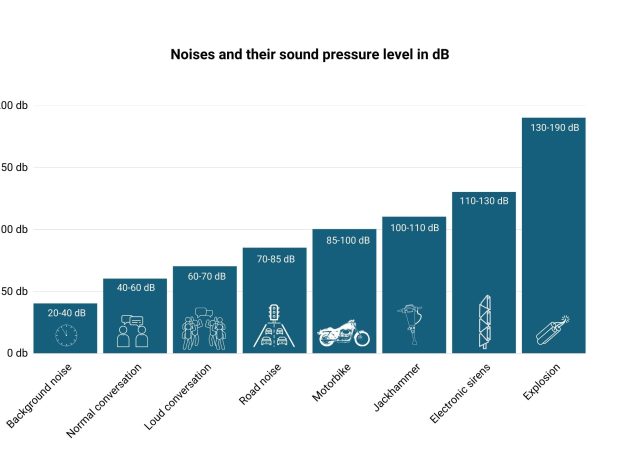When planning sirens, the term sound pressure level often comes into play, a complex topic - you can find all the information here.
Sound propagates in the form of vibrations, which are known as sound waves (Ronner, n.d.). The sound waves stimulate the eardrum and are perceived by the brain as sound. Sound waves can differ in amplitude and frequency. The amplitude describes the propagation of the vibrations of a sound wave and thus determines the volume (dB) of a sound. A low sound pressure level corresponds to a quiet sound environment, a high level to a loud one (Dr Antwerpes et al., 2019). The depth or height of a sound is determined by the frequency (Hz) of a sound, which is the number of oscillations of a sound wave per second. The human ear is particularly sensitive to sounds in the 3,000 – 4,000 Hz range.
For orientation, here are some examples of sounds with their volume in sound pressure level (dB) and their frequency in Hertz (Hz):
Sound pressure level – influencing factors
How we perceive the volume of a sound or a sound source depends not only on the frequency characteristics but also on the ambient conditions and the type of sound source. The nature of the environment, in particular the presence of obstacles, has a major influence on sound propagation. In an enclosed space, sound can be reflected and amplified, while outdoors it can be radiated and attenuated. If the sound encounters an obstacle such as a wall, a building, or a hill, it can be absorbed, reflected, or diffracted.
The direction of sound propagation (directional characteristic) is also decisive for the perception of volume. Some loudspeakers or sirens have directional sound radiation, i.e. the sound is bundled and transmitted to the directional area. In civil protection, it is generally desirable for alarms to cover the entire area. High-quality sirens emit sound omnidirectionally.
The distance to the sound generator also has a major influence on the sound pressure level of a sound wave. The greater the distance to the sound generator, the lower the sound pressure level of the sound wave, i.e. the volume of the sound decreases. The reason for this is that sound sets the molecules of substances, but also air, in motion. In the process, the energy of the sound wave is released and gradually absorbed (Tontechnik-Seminar, n.d.). Low-frequency sound waves lose significantly less sound pressure than high-frequency sound waves. We are familiar with this in everyday life: low-frequency sounds such as bass can be heard from a much greater distance than high-frequency sounds such as overtones.
Sound pressure level and erroneous assumptions
Incorrect assumptions are often made when it comes to sound pressure levels, so we would like to clarify a few points here regarding subjectively perceived sound levels:
- Doubling the power (in watts) of the sound generator results in an increase in sound pressure level of approximately 3 dB. An increase of 3 dB is only perceived by the human ear as a slight change in volume. To double the perceived volume, the power of a sound generator must be increased tenfold!
- Pneumatic sirens may seem louder than electronic sirens to many people, but modern electronic sirens deliver a higher sound pressure level. The difference is that pneumatic sirens also emit more overtones, to which the human ear is sensitive.
- Electronic sirens deliver a higher sound pressure level than motor sirens, such as the E57. Nevertheless, some people find a motor siren louder. This is because the sound of the E57 is emitted more strongly towards the ground due to the mushroom-shaped siren canopy (see picture below) – especially in the immediate vicinity of the siren.
We will be happy to advise you personally on procurement planning and all other aspects relating to large-scale alarm and warning systems. Security is important to us, we analyze your problem, identify potential for optimization and develop a transparent basis for decision-making for the implementation of a project. We provide you with individual support under the highest quality standards to ensure that your project is a success.
Sources information:
Berufsgenossenschaft der Bauwirtschaft. (n.d.). Frequenzen, Schalldruck und Lautstärken. Retrieved July 25, 2023 from: https://www.bgbau.de/themen/sicherheit-und-gesundheit/laerm-und-vibrationen/frequenzen-schalldruck-und-lautstaerken
Dr. Antwerpes, F.; Dr.Michel, O; Krüger, T.; Herzberg, M. (2019, June 1). Schalldruckpegel. DocCheck Flexikon. https://flexikon.doccheck.com/de/Schalldruckpegel
Dr.-Ing. Maue, J. H. (n.d.). Akustische Grundbegriffe. https://www.arbeitsplatz-laerm.de/fachinfos/akustische-grundbegriffe/
International Organization for Standardization. (2023). ISO 226:2023 Acoustics – Normal Equal-Loudness-Level Contours. Retrieved July 26, 2023 from: https://www.iso.org/standard/83117.html
Reitemeyer, D. (n.d.). Allgemeine Begriffe der Akustik. Driesen-Kern. https://www.driesen-kern.de/produkte/schallpegelmesser/allgemeine-begriffe-der-akustik.php
Ronner, M. (n.d.). Frequenz – Physikalische Einheit für Schwingungen pro Sekunde. Audiosana. https://www.audisana.ch/blog/frequenz
Sengpielaudio. (n.d.). Abnahme (Dämpfung) des Schallpegels in Dezibel (dB) in Abhängigkeit von der Änderung der Entfernung. Retrieved July 27, 2023 from: http://www.sengpielaudio.com/Rechner-entfernung.htm
Tontechnik-Seminar. (n.d.). Raumakustik. Retrieved July 27, 2023 from: https://www.tontechnik-seminar.de/exkurse/raumakustik/
Source images:
Adobe Stock
Freepik
Own Source




